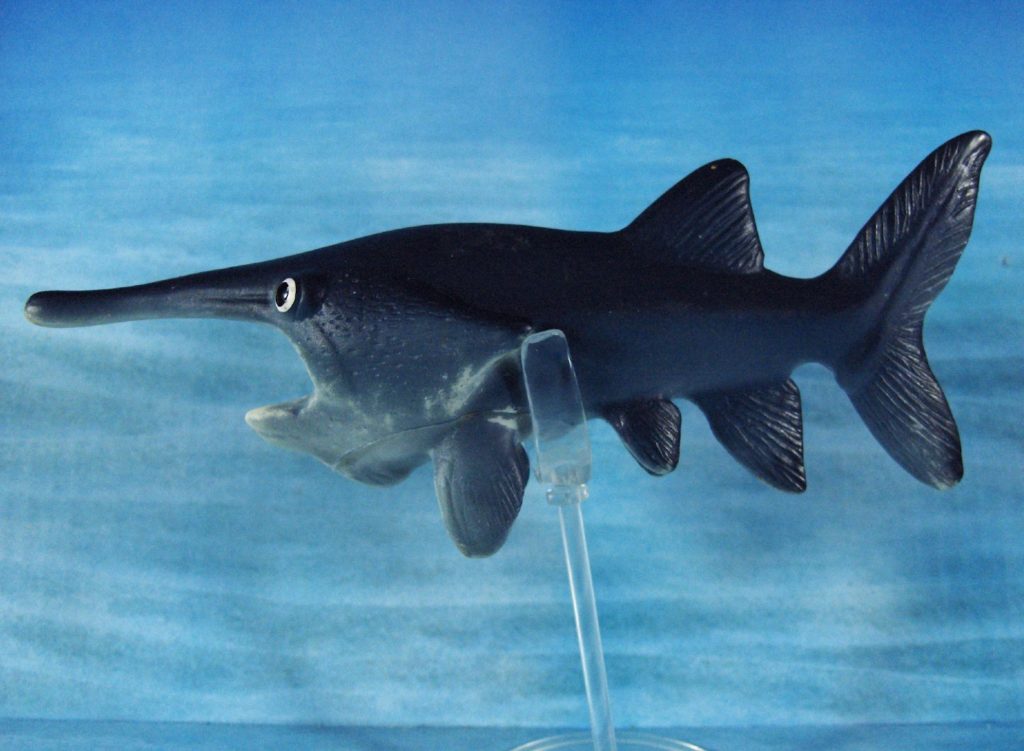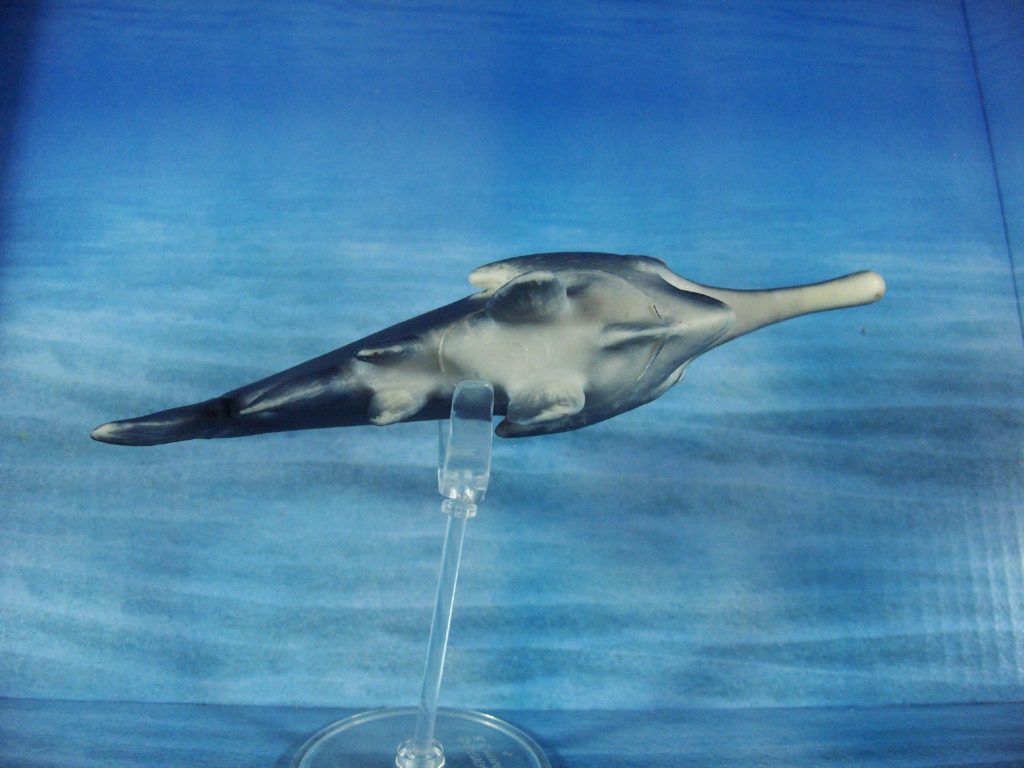
Welcome to a new year, and I’m starting with a bit of a memorial piece. Today I will discuss the American Paddlefish–in honour of the recently-declared-extinct Chinese Paddlefish Psephurus. Unfortunately…there are no figures of that particular animal at all–and not that many images out there either (most of the news reports featured pictures of the American paddlefish). So, I will look at one of the very few toys of the Polyodon spathula (Walbaum in Artedi 1792), the American paddlefish, which is still extant although in some areas they aren’t doing particularly well either.

Paddlefish are part of the fish family Polyodontidae in the order Acipenseriformes, relatives of the more diverse and widespread sturgeons. Now restricted to rivers of North America (and, until recently, China), the family first shows up as fossils in the Cretaceous, from Caspian regions in Asia and North America (some not far from where I live!) Like sturgeon, they are considered primitive due to their cartilaginous skeletons, spiral valve intestines, and a few other features–as well, of course, due to the deep time fossil record. Sturgeon and paddlefish both have somewhat shark-like shapes, but very different lifestyles, reflected in their morphology.

Unlike the sturgeons, paddlefish are notable as pelagic, open water hunters. They have smaller eyes, no scales, and larger, heterocercal tails. Their most distinctive feature is of course their long, extended rostra (upper snouts) that in the American paddlefish (and others) appears flat and spatulate; in others, like the Chinese paddlefish, the snout seems to be more pointed and wedge-like. In either case, the snouts are loaded with electroreceptors, called Ampullae of Lorenzini (also like sharks!), which are well-suited to locating prey in murky water–and helpful for fish with poor visibility. Apparently Chinese paddlefish were fish hunters, but the American paddlefish is adapted for plankton feeding, with a large, mouth and large gill covers (which are also covered with electroreceptors). This figure is modeled after an open-mouthed feeding paddlefish.

So what is this figure? It’s a paddlefish figure made as a giveaway for a coffee company called Tchibo. I got it from a friend in Germany. I have no idea when it actually came out, or where exactly. I don’t even know how he got it! What I can say is that it is made as a squeeze toy/water squirting toy, so it is hollow and squeezable, made of a soft PVC. The open mouth has a hole in the centre, so that water can be drawn in and pushed out.

Overall, it’s surprisingly not bad. It is a little compressed in length as paddlefish tend to be more elongate, but that’s a consequence of the toy’s purpose. The figure is about 14 cm long; given the normal length of a paddlefish at 220 cm (a dwarf compared to the Chinese species, which was recorded as large as 7 m long), the scale is about 1:16. The figure is painted as a dark blue along the back, fading a bit at the mid-line, and then white on the ventral surface. The underside of the rostrum and inside of the mouth is also white. The fins are all sculpted to have fin rays in them–for the tail, they even sculpted the upper lobe of the tail, with the fin rays surrounding it. The body is appropriately smooth, with some small denticles on the gill covers. As mentioned, the mouth is sculpted open, though not fully open, and the gill covers are flat against the body. These covers are not extended quite far enough back, but it could be due to the shortened body. The only major complaint might be that the eyes are very large, and forward facing–very much not in keeping with an actual paddlefish.

Overall, this is not a bad representation of the American paddlefish, if a little cartoonish and stylized (especially those eyes). Unfortunately, there aren’t many options for paddlefish figures out there–I have a fairly substantial number of them, but most are customs or 3D printed models. Or unavailable (Diramix made a rubbery one too, not sure how available it is). It would be great to recommend this figure, but I cannot honestly tell you how or where to get one. It’s too bad–we’ve already lost one of the 2 modern paddlefish species, and the American paddlefish is considered vulnerable through much of its range (extirpated from Canada about a century ago) as well–mostly due to habitat fragmentation and exploitation. So let’s try to encourage a major company to make a figure of this species, maybe we can make this species more familiar, and keep them from being lost forever as well…
Disclaimer: links to Ebay and Amazon on the AnimalToyBlog are affiliate links, so we make a small commission if you use them. Thanks for supporting us!




Nice. It is a little ‘cartoony’ but the actual animal is so bizarre it is almost acceptable here. Would love to have this species in my Synoptic Collection!
I have lots of different ones, of varying quality. The best is the My Favorite of course. Or my Whittier decoys one (it was my only option at the time). But you can ask Brett about My Favorite. I only got it because of a trade.
how big are these? I probably wouldn’t want something greater than 10.0 cm (but I’d be OK with this 14 cm Tchibo figure…)
The My Favorite is a little shorter, I think, but more slender. Would definitely suit your purposes well. I’m hoping Toy Fish Factory hurries up with their primitive fishes and finally makes a commercial paddlefish for all!
I had the opportunity to visit a fish hatchery that raised these, back in my college days. They had several different life stages, but no giants of course. I even got to touch one. An experience I’ll never forget and one of my favorite fishes since then. I might have to track this toy down. Absolutely devastating that we lost the Chinese paddelfish.
If you can find it, it’s pretty cool. I was lucky to trade to get it.
I would like to visit a hatchery that raises them some time. But it would be a bit of a trip, they’re not native at all!
What a funny figure. The hole in the mouth, in that picture from the front, make it look like it’s saying “oooooh” in surprise. ;D
It turns out paddlefish always kind of look like that when their mouths open… they’re almost living cartoons!
[…] © Animal Toy Forum […]
What a strange link…too bad one of the better photos doesn’t show on their page!